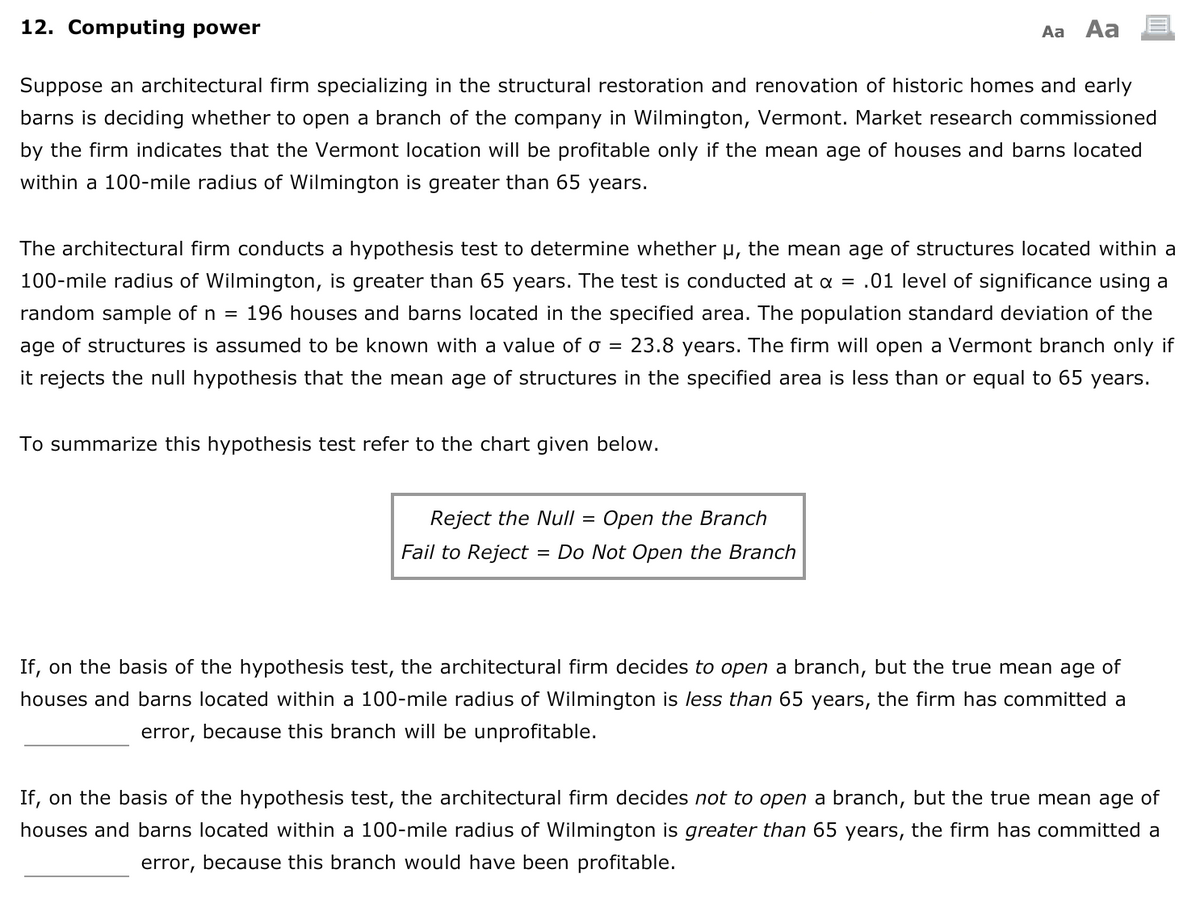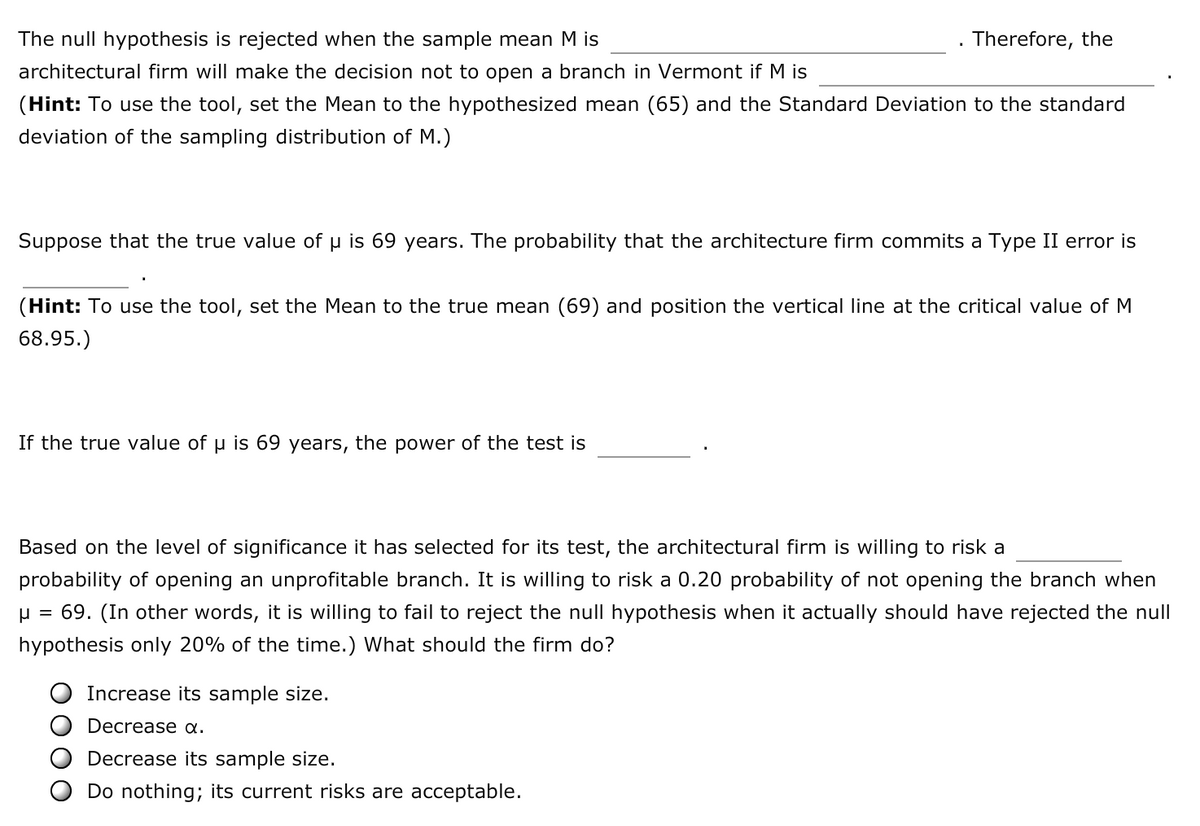Suppose an architectural firm specializing in the structural restoration and renovation of historic homes and early barns is deciding whether to open a branch of the company in Wilmington, Vermont. Market research commissioned by the firm indicates that the Vermont location will be profitable only if the mean age of houses and barns located within a 100-mile radius of Wilmington is greater than 65 years. The architectural firm conducts a hypothesis test to determine whether µ, the mean age of structures located within a 100-mile radius of Wilmington, is greater than 65 years. The test is conducted at a = .01 level of significance using a random sample of n = 196 houses and barns located in the specified area. The population standard deviation of the age of structures is assumed to be known with a value of o = 23.8 years. The firm will open a Vermont branch only if it rejects the null hypothesis that the mean age of structures in the specified area is less than or equal to 65 years. To summarize this hypothesis test refer to the chart given below. Reject the Null = Open the Branch Fail to Reject = Do Not Open the Branch If, on the basis of the hypothesis test, the architectural firm decides to open a branch, but the true mean age of houses and barns located within a 100-mile radius of Wilmington is less than 65 years, the firm has committed a error, because this branch will be unprofitable. If, on the basis of the hypothesis test, the architectural firm decides not to open a branch, but the true mean age of houses and barns located within a 100-mile radius of Wilmington is greater than 65 years, the firm has committed a error, because this branch would have been profitable.
Suppose an architectural firm specializing in the structural restoration and renovation of historic homes and early barns is deciding whether to open a branch of the company in Wilmington, Vermont. Market research commissioned by the firm indicates that the Vermont location will be profitable only if the mean age of houses and barns located within a 100-mile radius of Wilmington is greater than 65 years. The architectural firm conducts a hypothesis test to determine whether µ, the mean age of structures located within a 100-mile radius of Wilmington, is greater than 65 years. The test is conducted at a = .01 level of significance using a random sample of n = 196 houses and barns located in the specified area. The population standard deviation of the age of structures is assumed to be known with a value of o = 23.8 years. The firm will open a Vermont branch only if it rejects the null hypothesis that the mean age of structures in the specified area is less than or equal to 65 years. To summarize this hypothesis test refer to the chart given below. Reject the Null = Open the Branch Fail to Reject = Do Not Open the Branch If, on the basis of the hypothesis test, the architectural firm decides to open a branch, but the true mean age of houses and barns located within a 100-mile radius of Wilmington is less than 65 years, the firm has committed a error, because this branch will be unprofitable. If, on the basis of the hypothesis test, the architectural firm decides not to open a branch, but the true mean age of houses and barns located within a 100-mile radius of Wilmington is greater than 65 years, the firm has committed a error, because this branch would have been profitable.
MATLAB: An Introduction with Applications
6th Edition
ISBN:9781119256830
Author:Amos Gilat
Publisher:Amos Gilat
Chapter1: Starting With Matlab
Section: Chapter Questions
Problem 1P
Related questions
Topic Video
Question

Transcribed Image Text:12. Computing power
Aa Aa
Suppose an architectural firm specializing in the structural restoration and renovation of historic homes and early
barns is deciding whether to open a branch of the company in Wilmington, Vermont. Market research commissioned
by the firm indicates that the Vermont location will be profitable only if the mean age of houses and barns located
within a 100-mile radius of Wilmington is greater than 65 years.
The architectural firm conducts a hypothesis test to determine whether u, the mean age of structures located within a
100-mile radius of Wilmington, is greater than 65 years. The test is conducted at a = .01 level of significance using a
random sample of n = 196 houses and barns located in the specified area. The population standard deviation of the
age of structures is assumed to be known with a value of o = 23.8 years. The firm will open a Vermont branch only if
it rejects the null hypothesis that the mean age of structures in the specified area is less than or equal to 65 years.
To summarize this hypothesis test refer to the chart given below.
Reject the Null =
Open the Branch
Fail to Reject
= Do Not Open the Branch
If, on the basis of the hypothesis test, the architectural firm decides to open a branch, but the true mean age of
houses and barns located within a 100-mile radius of Wilmington is less than 65 years, the firm has committed a
error, because this branch will be unprofitable.
If, on the basis of the hypothesis test, the architectural firm decides not to open a branch, but the true mean age of
houses and barns located within a 100-mile radius of Wilmington is greater than 65 years, the firm has committed a
error,
because this branch would have been profitable.

Transcribed Image Text:The null hypothesis is rejected when the sample mean M is
Therefore, the
architectural firm will make the decision not to open a branch in Vermont if M is
(Hint: To use the tool, set the Mean to the hypothesized mean (65) and the Standard Deviation to the standard
deviation of the sampling distribution of M.)
Suppose that the true value of u is 69 years. The probability that the architecture firm commits a Type II error is
(Hint: To use the tool, set the Mean to the true mean (69) and position the vertical line at the critical value of M
68.95.)
If the true value of u is 69 years, the power of the test is
Based on the level of significance it has selected for its test, the architectural firm is willing to risk a
probability of opening an unprofitable branch. It is willing to risk a 0.20 probability of not opening the branch when
u = 69. (In other words, it is willing to fail to reject the null hypothesis when it actually should have rejected the null
hypothesis only 20% of the time.) What should the firm do?
Increase its sample size.
Decrease a.
Decrease its sample size.
Do nothing; its current risks are acceptable.
Expert Solution
This question has been solved!
Explore an expertly crafted, step-by-step solution for a thorough understanding of key concepts.
This is a popular solution!
Trending now
This is a popular solution!
Step by step
Solved in 3 steps

Knowledge Booster
Learn more about
Need a deep-dive on the concept behind this application? Look no further. Learn more about this topic, statistics and related others by exploring similar questions and additional content below.Recommended textbooks for you

MATLAB: An Introduction with Applications
Statistics
ISBN:
9781119256830
Author:
Amos Gilat
Publisher:
John Wiley & Sons Inc

Probability and Statistics for Engineering and th…
Statistics
ISBN:
9781305251809
Author:
Jay L. Devore
Publisher:
Cengage Learning

Statistics for The Behavioral Sciences (MindTap C…
Statistics
ISBN:
9781305504912
Author:
Frederick J Gravetter, Larry B. Wallnau
Publisher:
Cengage Learning

MATLAB: An Introduction with Applications
Statistics
ISBN:
9781119256830
Author:
Amos Gilat
Publisher:
John Wiley & Sons Inc

Probability and Statistics for Engineering and th…
Statistics
ISBN:
9781305251809
Author:
Jay L. Devore
Publisher:
Cengage Learning

Statistics for The Behavioral Sciences (MindTap C…
Statistics
ISBN:
9781305504912
Author:
Frederick J Gravetter, Larry B. Wallnau
Publisher:
Cengage Learning

Elementary Statistics: Picturing the World (7th E…
Statistics
ISBN:
9780134683416
Author:
Ron Larson, Betsy Farber
Publisher:
PEARSON

The Basic Practice of Statistics
Statistics
ISBN:
9781319042578
Author:
David S. Moore, William I. Notz, Michael A. Fligner
Publisher:
W. H. Freeman

Introduction to the Practice of Statistics
Statistics
ISBN:
9781319013387
Author:
David S. Moore, George P. McCabe, Bruce A. Craig
Publisher:
W. H. Freeman